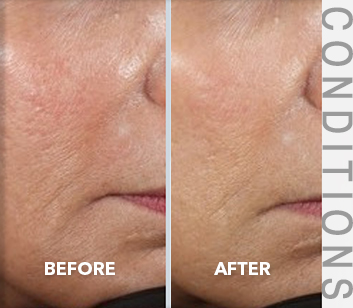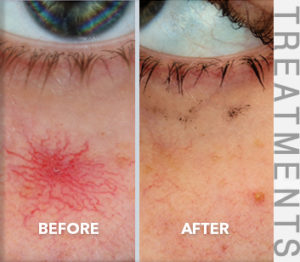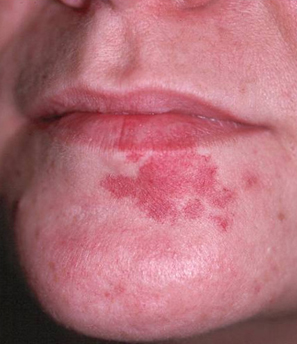Conditions
Port-Wine Stains
Results of Treatment
Port-wine stains are generally treated at 6-week intervals. Port-wine stains on the extremities may take longer than other areas for the skin to heal back to normal.
About Port-Wine Stains
Port-wine stains (PWSs) and hemangiomas are common red birthmarks. Often, some of these marks, like the very common, red patch or ‘stork bite’ on the back of the neck, resolve over time, often by age 4. It’s important to show these marks to a pediatrician, since they often show themselves at, or sometime after, birth. Mostly these marks just affect the skin, but less commonly they are can affect the brain or the eyes, so examination by a pediatrician is important. They can be treated shortly after birth, or at any time in a person’s life. I often treat PWSs for the first time in adults. Often people seek treatment because flat birthmarks develop raised areas over time, or simply because people seek treatment after hearing about how well the newest generation of lasers work at removing port-wine stain birthmarks.
The good news is that lasers have gotten exceedingly good at removing these marks without damaging the skin they are a part of. The pulsed-dye lasers, including the V-Beam Perfecta® and V-Beam Prima® lasers, remove port-wine stains and even some hemangiomas, often completely, without a trace. Removal generally takes a series of treatments, usually administered at 6-8 week intervals. Immediately after treatment, the birthmark becomes bruised and looks quite purple for about 2 weeks. Newer pulsed-dye lasers can remove birthmarks that were incompletely removed by older-generation lasers.
To answer your specific questions or schedule a consultation, call Dr. Bernstein today at 610-645-5551.
Did you know?
Dr. Bernstein was the first physician in the WORLD to use the V-Beam Perfecta® and V-Beam Prima® lasers and one of the first in the U.S. to acquire the Excel-V® laser has published numerous peer-reviewed articles on treating numerous conditions with these lasers and has published extensively on their use, including on the treatment of port-wine stains.
Port-Wine Stains FAQs
IF I WASN'T BORN WITH IT, HOW CAN IT BE A BIRTHMARK?
Port-wine stains are present at birth and also occur months or years after birth. They can even be acquired during adult hood. They involve areas of the skin supplied by certain nerve groups, because during development in the womb alterations may occur in some cells that produce excess blood vessels along the course of a nerve. During development, nerves and blood vessels often develop together. For this reason it is critical to see a pediatrician to look for changes in port-wine stain or involvement of other systems like the brain or eyes. Most port-wine stains do not involve the brain or eyes, but port-wine stains involving certain areas of the face are more likely to involve the central nervous system. There can also be associated involvement of organ systems with vascular birthmarks. Port-wine stains of the extremities associated with deeper hemangiomas may lead to problems in the affected limb, or even affect blood platelets. These are rare conditions, but illustrate why follow-up with pediatricians or interests is important for people with port-wine stains or hemangiomas.
AS AN ADULT WITH A PORT-WINE STAIN, DO I NEED TO SEE A DOCTOR FOR EVALUATION?
People with port-wine stains around the eyes or on the face need to be sure to have a yearly eye exam. Just as port-wine stains can grow on the skin, so can they grow or change in the eye and glaucoma can be associated with some facial port-wine stains. Sometimes limbs with port-wine stains can become bigger than the opposite limb and this can be monitored. Most of the time, port-wine stains just affect the skin.
WHAT LASERS ARE USED TO TREAT PORT-WINE STAINS?
The gold standard for treating port-wine stains is the pulsed-dye laser, including the V-Beam Perfecta® and V-Beam Prima® lasers and others. These lasers target the hemoglobin within blood vessels, heating them without damaging the surrounding skin. People sometimes use other lasers to treat thicker areas of port-wine stains such as the alexandrite or Nd:YAG lasers. These lasers penetrate more deeply than pulsed-dye lasers and are less well absorbed by oxyhemoglobin so they can be less forgiving and more at risk for harming the skin. They should only be used by very experienced laser surgeons who treat many port-wine stains.
WHAT IS STURGE-WEBER SYNDROME?
Sturge-Weber syndrome is a rare condition characterized by a port-wine stain involving the upper face and eyelid or other areas of the face together with neurological involvement producing symptoms such as seizures or glaucoma. It is named after 2 physicians who described it. Information about Sturge-weber syndrome can be found through the Sturge-Weber Foundation (SWf0 at www.sturge-weber.org.
HOW MANY LASER TREATMENTS WILL IT TAKE TO REMOVE MY PORT-WINE STAIN?
Every port-wine stain is different and every location responds differently. For example, port-wine stains on the neck are often removed in a few treatments while those on the lower leg or foot can require many treatments for removal. The real answer is that no one can tell you how many treatments it will take to remove your port-wine stain, or even IF it can be removed completely.
HOW LONG BETWEEN PORT-WINE STAIN TREATMENTS?
Port-wine stains are generally treated at 6 week intervals. Port-wine stains on the extremities may take longer than other areas for the skin to heal back to normal, and thus treatments may be spaced further apart.
WHAT ARE THE POSSIBLE SIDE EFFECTS OF PORT-WINE STAIN TREATMENT?
Immediately following treatment, port-wine stains look quite bruised. The bruising worsens with time making them look purple like an eggplant. This bruising usually last for 2 weeks or more. In addition, as with any bruise, brown pigmentation composed of destroyed red blood cells and surface melanin pigment can occur at treatment sites. It’s very important to wait until this pigment resolves before getting additional treatments, as treating over this pigment can result in injury to the skin. Blistering or crusting can occur in some areas of a port-wine stain following treatment, although bruising is far more common.
DOES LASER TREATMENT OF PORT-WINE STAINS HURT?
Port-wine stain treatment can be uncomfortable and how uncomfortable depends a lot on the area to be treated. Numbing creams can be used on the skin before treatment, but usually adults tolerate the treatments quite well without it.
HOW DO I CARE FOR THE TREATED AREA?
People apply petrolatum (Vaseline® or Aquaphor®) to the treated areas a few times a day, for 1-2 weeks after treatment, or until the skin has healed completely.
CAN PORT-WINE STAINS RECUR OR CHANGE?
Port-wine stains can recur following their removal, so repeated treatment may be necessary. There’s no way to prevent that. In addition, port-wine stains can also develop red bumps or blebs and thicken in areas. It’s super important to seek treatment if this begins to happen as thickened areas are more resistant to treatment. Even if your port-wine stain was previously treated, newer lasers can remove port-wine stains that stopped responding to earlier-generation lasers.







